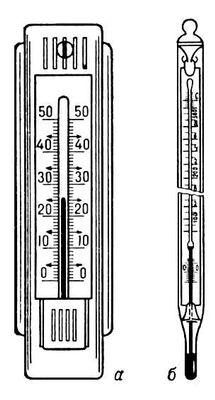1203
Thermometer, whose do you?
The modern household thermometer - instrument by which we measure the temperature - no specific author. We can speak only of those who offered a particular scale used in the thermometer. So, now used four scales: Celsius (probably the most common), Fahrenheit, Reaumur and Kelvin (used in scientific measurements). But the idea of a device that if they do not measure the temperature, but at least it was assessed by the famous Italian scientist Galileo Galilei. He invented thermoscope, representing a small vessel with a very narrow neck. The vessel is filled with water (about half) that upon heating of the medium moved through the neck. As you can see, the scale has not happened. Temperatures compared at a lifting height of the column of water in thermoscope.

The word "thermometer" was coined by Dutch K. Drebbel inventor "drebbeleva tool" to measure the temperature. That was in 1636. His thermometer had eight divisions and has been the gas - by heating it expanded air. Some progress in temperature measurement can be seen in the work of Isaac Newton "On a scale of degrees of heat and cold", where the proposed scale, consisting of 12 divisions.
The first liquid thermometer - on account of the German physicist G. Fahrenheit, which in 1709 produced alcohol, and in 1724 the mercury devices. However, the greatest merit of Fahrenheit is he one of the first to think about the accuracy of the thermometer and tried to achieve it by taking a few points with known temperature, which struck on his scale. For 0 degrees Fahrenheit took the lowest temperature of a cold winter in 1709. The second characteristic point he took the temperature of melting ice, the third - the temperature of the human body and the fourth - the boiling point of water. In its first thermometer was 212 degrees (32 degrees - the melting of ice, 98 is a normal human body temperature, 212 - the boiling point of water). Fahrenheit scale (true 180-degree) is still popular in the United States and the United Kingdom.
In Russia, has long been in the course of the scale proposed in 1730 by French naturalist R. Reaumur. It had 80 divisions, and the range of temperatures is about the same as that of Fahrenheit (from freezing to boiling water). Almost two centuries, Russians have used these thermometers is not switched to Celsius - the one by which today measures the temperature of almost the entire world. This 100-degree scale was first introduced in 1742. Its author - a Swedish physicist and astronomer A. Celsius.

The word "thermometer" was coined by Dutch K. Drebbel inventor "drebbeleva tool" to measure the temperature. That was in 1636. His thermometer had eight divisions and has been the gas - by heating it expanded air. Some progress in temperature measurement can be seen in the work of Isaac Newton "On a scale of degrees of heat and cold", where the proposed scale, consisting of 12 divisions.
The first liquid thermometer - on account of the German physicist G. Fahrenheit, which in 1709 produced alcohol, and in 1724 the mercury devices. However, the greatest merit of Fahrenheit is he one of the first to think about the accuracy of the thermometer and tried to achieve it by taking a few points with known temperature, which struck on his scale. For 0 degrees Fahrenheit took the lowest temperature of a cold winter in 1709. The second characteristic point he took the temperature of melting ice, the third - the temperature of the human body and the fourth - the boiling point of water. In its first thermometer was 212 degrees (32 degrees - the melting of ice, 98 is a normal human body temperature, 212 - the boiling point of water). Fahrenheit scale (true 180-degree) is still popular in the United States and the United Kingdom.
In Russia, has long been in the course of the scale proposed in 1730 by French naturalist R. Reaumur. It had 80 divisions, and the range of temperatures is about the same as that of Fahrenheit (from freezing to boiling water). Almost two centuries, Russians have used these thermometers is not switched to Celsius - the one by which today measures the temperature of almost the entire world. This 100-degree scale was first introduced in 1742. Its author - a Swedish physicist and astronomer A. Celsius.
As a person must answer when he was asked: "What most helps to become diligent and reach the goal?"
Another Hundred Years War.























